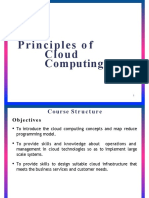0% found this document useful (0 votes)
75 views2 pagesUnit
Cloud computing delivers computing services over the internet, offering flexibility and cost-effectiveness. It includes characteristics such as on-demand self-service and rapid elasticity, with deployment models like public, private, and hybrid clouds. Despite its advantages, challenges such as data security and vendor lock-in remain significant concerns.
Uploaded by
shrutimanval104Copyright
© © All Rights Reserved
We take content rights seriously. If you suspect this is your content, claim it here.
Available Formats
Download as DOCX, PDF, TXT or read online on Scribd
0% found this document useful (0 votes)
75 views2 pagesUnit
Cloud computing delivers computing services over the internet, offering flexibility and cost-effectiveness. It includes characteristics such as on-demand self-service and rapid elasticity, with deployment models like public, private, and hybrid clouds. Despite its advantages, challenges such as data security and vendor lock-in remain significant concerns.
Uploaded by
shrutimanval104Copyright
© © All Rights Reserved
We take content rights seriously. If you suspect this is your content, claim it here.
Available Formats
Download as DOCX, PDF, TXT or read online on Scribd
/ 2




















































































